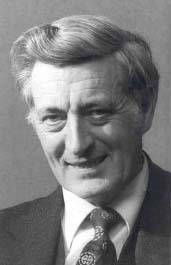|
locked to his wrist
and hid it behind clothes in a wardrobe before he and Margaret went out on a
date.
After hostilities ceased, James married Margaret, completed his DPhil and
continued to work at Harwell on projects relating to the peaceful use of
atomic energy and radiochemistry. James and Margaret travelled widely
through Wales, Ireland, France and Switzerland.
James had a strong desire to promulgate science and to work with young
people, and hence joined the Chemistry Department, Melbourne University in
1953 as a Reader in Radiochemistry. This marked the beginning of a
distinguished academic career in which, amongst other things, he contributed
significantly to the development and understanding of radiochemistry. As a
co-author he published his first book "Modern radiochemical practice" and
later authored a second book "Isotopes in chemistry" which was a standard
text for many university radiochemistry courses.
He toured and lectured widely on radiochemistry, visiting Victoria
University of Wellington in 1961. As a consequence he applied for and was
appointed to the newly established Chair of Inorganic and Theoretical
Chemistry at Victoria in 1962, which he held until he retired in 1986. He
was Head of the former Chemistry Department from 1968 to 1980.
James had a very keen, active and enquiring mind and was an inspirational,
patient and effective teacher. He was also an equally inspirational and
innovative researcher, and led and supervised a strong research group of MSc
and PhD students in a wide range of fundamental and applied research
programmes. Much of the research necessitated designing and building
equipment for the task at hand as well as carrying out the experimental
programme and interpreting the results as best as the data allowed.
Accordingly, his students received a valuable research education as the
science itself was supplemented by innovation, inventiveness and
stickability. Many of his students now hold senior positions in
science-based public and private sector organisations within New Zealand and
internationally. Through his research and teaching he contributed
significantly to the national and international knowledge base of chemistry,
radiochemistry and materials science.
In 1964 he was quick to develop and progress an active research programme in
the Moessbauer Effect or nuclear gamma ray resonance spectroscopy, recently
discovered by Nobel Laureate Rudolph Moessbauer. James and his research
group made a leading contribution to Moessbauer Spectroscopy over many
years. They measured and published Fe-57 Moessbauer spectra and parameters
for numerous iron-containing compounds and minerals, and used the data to
develop an enhanced understanding of the structure and chemistry of these
materials. He extended his research to solid state chemistry where he and
his group contributed significantly to understanding the chemistry,
structures and reactions of clay-based ceramics, minerals, fertilisers, New
Zealand ironsands and indeed of teeth and tooth decay. He was proactive in
establishing research collaborations with the then DSIR and Industry. Many
of his students enjoyed and benefited from the opportunity to work in such
collaborative programmes. These collaborations are continued in a similar
form today and are led by his postgraduate students. There is no doubt that
James' pioneering work and influence in solid state chemistry and materials
science in New Zealand has provided a cornerstone for the current
collaborations and internationally recognised materials science research in
the School of Chemical and Physical Sciences, Victoria University, and
Industrial Research Ltd.
He recognised the potential of stimulating and extending the enquiring
scientific minds of secondary school students and in 1964 organised the
first Wellington Secondary Schools Science Fair. This has grown
progressively over the years to a prestigious event, held annually in all
the main centres with a National Final, under the auspices of the Royal
Society of New Zealand and sponsored by New Zealand corporates. Today, in
the Wellington area alone, some 350 students each year exhibit their science
fair projects. James chaired the Wellington Region Science Fair Committee
for many years and also the National Science Fair Board. He then became
Patron of the National Science Fair as it evolved from his enterprise to the
responsibility of the Royal Society of New Zealand. The New Zealand wide
Science Fairs have indeed done much to enhance student interest and public
awareness of the importance of science and technology.
James was very forward thinking and encouraged senior public and private
sector persons to identify, consider and debate future issues likely to be
of major significance to New Zealand and its people. He was a foundation
member of the National Development Council of New Zealand from 1969 to 1974
and in 1975 he persuaded Government to establish the Commission for the
Future, which he was then asked to Chair. The Commission advised Government
on the longer-term effects of policies and likely development scenarios for
New Zealand. It produced a number of far-sighted reports, one of which
concluded that the then policies of the Muldoon Government would likely lead
to higher unemployment and a widening income gap and social problems. The
Government apparently viewed such a prediction dimly and disbanded the
Commission in 1982. Interestingly, this prediction and a number of other
outcomes predicted by the Commission appear to have rung remarkably true.
Still believing strongly in the need for this type of forward thinking,
James then established the New Zealand Futures Trust, a charitable
organisation which continues today in promoting the difficult quest of
getting people to think more about the long-term effects of current and
proposed policies and developments. In 1984, James authored a book of
"Options for New Zealand's Future" which presented much of these arguments
and conclusions. Even with his deteriorating physical health James continued
to write and contribute to science and society by e-communications from his
farm in Mahau Sound.
James' contribution to science has been recognised by his DSc from Oxford
University, and Fellowships of the Royal Society of New Zealand and the New
Zealand Institute of Chemistry. His OBE recognises the wider contributions
he has made to science. |

